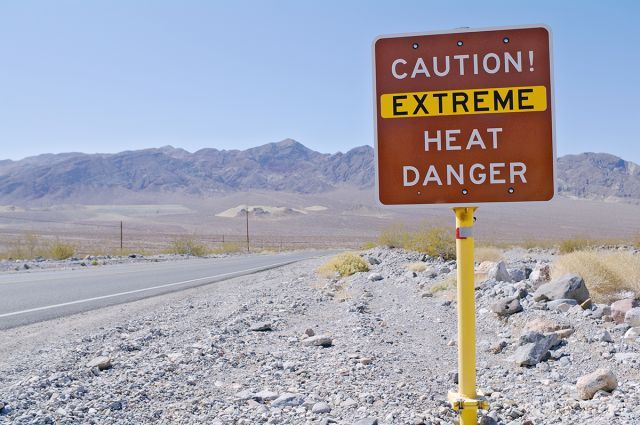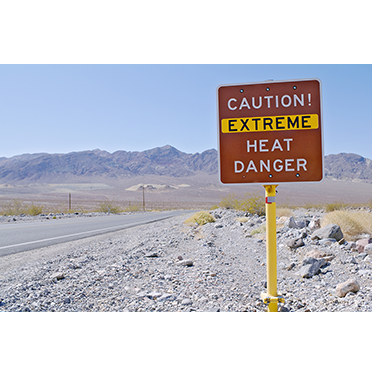About Extreme Heat
Extreme heat is defined as weather that is “substantially hotter and/or more humid than average for a location at that time of year.” Heat makes our bodies work harder to maintain a normal temperature, which can cause serious illness and even death. Extreme heat is very deadly and is responsible for the highest number of annual deaths among all natural hazards.
Climate change is making extreme heat more common and more extreme. Places that have typically been cool, such as the Bay Area, have more extreme heat days than ever before. This new normal is challenging because the Bay Area, for example, isn’t equipped with the infrastructure (like air conditioning in most homes) to deal with extreme heat.
Extreme heat is also exacerbated by what’s known as the urban heat island effect. It occurs because our cities are full of concrete that traps and retains heat. This means hotter days and hotter nights for the urban area and its surroundings. One of the best studies of the impacts of heat in a city is Heat Wave: A Social Autopsy of Disaster in Chicago.
Impact on Frontline Communities

Extreme heat and its secondary disasters disproportionately harm the elderly and immunocompromised, people with low incomes, communities of color, people experiencing homelessness, farmworkers and construction workers, and people with disabilities. People living in urban areas suffer disproportionately under the urban heat island effect.
Research finds that in California subsidized affordable homes are more vulnerable to extreme heat because households lack funds to cover increased energy costs associated with air conditioning and related utilities.
Actions to Take
For individuals and households
- Follow along with the National Weather Service and local government officials to be prepared for hot days. OSHA-NIOSH is a great smartphone app for understanding how hot it feels.
- Block sunlight and heat. Use heavy curtains, reflective film, solar blankets, or cardboard in windows.
- Look for "cooling centers" available near you. These are temporary spaces with air conditioning that are open during extreme heat days.
- Use AARP’s toolkit to help others stay cool during extreme heat.
- Check out the Low-Income Home Energy Assistance Program, which helps eligible low-income households with the goal of managing and meeting their immediate home heating and or cooling needs.
For community-based organizations and affordable housing developers
- Create a Heat Wave Strategy like this one from the Resilient Bayview. The Center for Disease Control also has guidance on creating a Heat Response Plan. Partner with your local Office of Emergency Services to see if the Community Emergency Response Teams (CERT) could help check on community members during extreme heat days.
- Use the Enterprise Ready to Respond Tool to create a Business Continuity Plan for your Residents, Buildings, and Operations.
- Use these Resilience Strategies for Multi-Family Buildings. One strategy includes establishing a resilience room that serves as a cooling, clean air center, and holder of emergency supplies. Other strategies include adding cooling features to buildings and backup power systems and shading windows.
- The California Low Income Weatherization Program for Multifamily Properties may be able to support you in saving energy costs and reducing greenhouse gas emissions. Your local Office of Emergency Services may be able to provide you with some emergency supplies typically via a “cache” program.
- Inform community members, including tribal communities, about the Low-Income Home Energy Assistance Program and other programs that can help with energy costs. Advocate that the program be expanded, faster, and inclusive of more people.
- Establish floor or wellness captains to check on community members, especially those most impacted by extreme heat. Survival happens when neighbors know each other! This worksheet explains what floor captains could do. Your city’s Office of Emergency Management likely offers trainings that could prepare floor captains to lead around extreme heat. Seattle has lots of great resources and trainings, for example.
- Inform outdoor workers of their rights and report violations. Here is a list of ways to protect workers. Advocate for more resources for the California Occupational Safety and Health Agency so that they can enforce regulations.
For local and State governments
- Use the California Heat Assessment Tool (CHAT) to see the map of your jurisdiction and its heat risks.
- Create a heat response plan in multiple languages working in partnership with frontline communities and community-based organizations. Use this guidance from the Center for Disease Control. Be sure to include ways to protect people who are incarcerated from sweltering conditions, too.
- Make sure to have cooling centers available in neighborhoods with high percentages of people of color, people with low-incomes and affordable housing. Choose spaces that are already gathering places in these communities and invest in making them heat-resistant.
- Start a Community Safety Ambassador Program like the one in Seattle.
- Create a tree planting and heat awareness program in partnership with frontline communities. This tool from the California Forest Services shows the tree canopy in urban areas.
- Look for opportunities to incorporate cooling infrastructure and alternative energy sources into your resilience plans and projects. Cool roofs, for example, can lower reliance on air conditioning, which greatly contributes to climate change. For example, Climate Resolve is leading a project to install cool roofs in communities traditionally left out of the green economy.
- Follow the Heat Adaptation Workgroup of the California Climate Action Team’s Preparing California for Extreme Heat: Guidance and Recommendations that has many ideas for local and state government.
- Prioritize the hiring and staffing for the California Occupational Safety and Health Agency so that there is more capacity for education and enforcement of the state’s strong worker protections.
- Explore the option of Green Leases or energy-aligned leases that incentivize both landlords and tenants to invest in efficient energy and or retrofits.
For philanthropy
- Support organizations that give money to people who are undocumented. They are usually not eligible or may be afraid to apply, for many assistance programs – especially from the Federal government. They may also be reluctant to take a day off when they need to rest or get relief from the heat.
- Fund the creation of cooling centers and other cooling infrastructures like shading and porous surfaces in frontline communities and in partnership with them.
- Fund and help plant trees in communities that need them.
- Create programs to fund energy assistance and alternative energy sources for frontline communities who might not qualify for other sources of funding or receive it fast enough.
- Support the United Farmworkers and other outdoor labor rights groups so that they can keep up their amazing work educating and fighting for workers' rights.

- Training